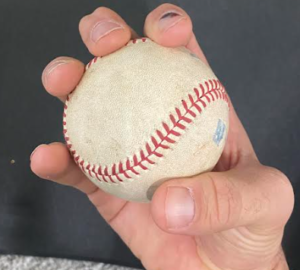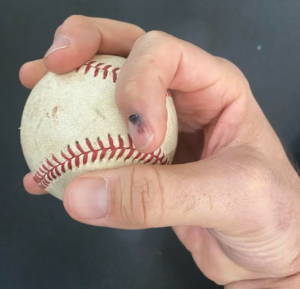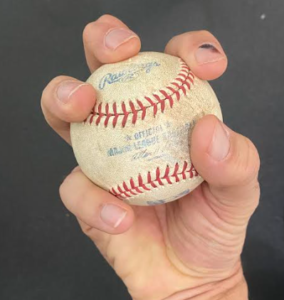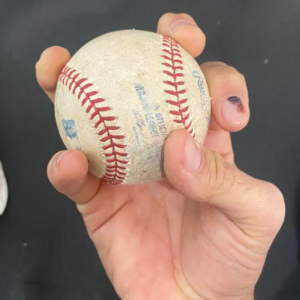A changeup is one of the most challenging offspeed pitches to throw for baseball pitchers.
With a changeup, the objective is to appear like you are throwing a fastball but have the ball be about 10-12 miles per hour slower.
Changeups keep hitters off balance by impacting their timing, and can take years for pitchers to master
Any slight slowdown in your arm speed can tip off the opposing hitter and signal a changeup is coming and result in a high likelihood that the pitch may get crushed by good hitters.
Watch 2018 Baseball Hall of Fame inductee Trevor Hoffman talk about the pitch that helped get him there! His famous changeup! https://t.co/RtmS8CjRJT pic.twitter.com/oRWIrdJcYC
— Perfect Game USA (@PerfectGameUSA) January 25, 2018
Contents
Most Popular Changeup Grips
Not every pitcher has the same hand size, so it is best to experiment with various change-up grips. Let’s take a look at the most popular grip options:
Straight Change
The straight change is the most popular change-up thrown for young players since the change-up grip is the closest to the regular fastball grip.
The straight change grip is grip with your index finger, middle finger, and ring finger evenly distributed throughout the ball.
This style of change-up typically doesn’t have the same amount of movement as a circle change-up would, but some feel like it is much easier to control.
Many leagues and coaches discourage pitchers from throwing curveballs to protect their arms in little league baseball. As a result. The ‘straight change’ is often the first offspeed type of pitch that young pitchers throw since it is an easy transition from the fastball.
Little league players may grip the entire baseball and throw a ‘palm ball’ since their fingers aren’t big enough for more complex change-up grips.
Circle Change
The circle change is a more advanced change up grip than the straight change and one you start to see in high school and college baseball.
A circle change has arm-side movement on the ball which makes it more deceptive then a straight change.
When you combine the 10mph speed distance with arm side movement, a good circle change is one of the toughest pitchers to hit in baseball.
That being said, it is also one of the toughest pitches to master. Throwing the circle change requires great feel on the pitcher’s part since the ball is released uniquely.
Any slight timing that is off is a pitchers delivery can result in a pitcher ‘short arming’ the change up in the dirt, or letting the pitch sail high and inside.
The circle change is a pitch of feel and it takes hundreds/thousands of repetitions to be able to consistently through the circle change up for strikes.
Star Changeup
The star changeup is another type of changeup grip that is commonly used amongst young players.
The star changeup grip looks like your fingers are spread out to replicate a star if you look at it the grip from the fron with all five fingers touching the ball.
The star changeup isn’t is popular as the circle change because the circle change typically generates more downward movement.
Once again, the most important thing about throwing the changeup is first to be able to consistently throw it for strikes.
Try the star grip out if you have issues controlling some of the other grip options.
Vulcan change up
The Vulcan changeup is a cobmbination of a split finger fastball and a forkball and is becoming more popular at the advanced levels of baseball.
It takes large fingers to be able to hold the volcan changeup since the fingers need to wrap around the outside of the baseball and still be able to control it.
If you struggle to command the circle changeup, the vulcan changeup could be a good alternative to experiment throwing.
7 Tips on how to perfect throwing the changeup
Here are some tips and ideas for getting comfortable with throwing the changeup:
1. Throw it while warming up
Tom Glavine, Changeup Grip [full video: https://t.co/g0CFzMmFCQ] pic.twitter.com/2gzVAinnDr
— Rob Friedman (@PitchingNinja) November 20, 2017
Since the change-up is such a unique grip the only way to truly get comfortable throwing the pitch is if you get tons of reps in.
When you are warming up before practice, make sure you incorporate throwing change-ups to your throwing partner from different distances.
One of the main objectives with the change up is to maintain the same arm speed that you throw your fastball with.
Throwing a change up from 90 feet or so on a line in a great way to build up confidence in your grip and arm speed.
Think about how many years of practice you have throwing a four seem fastball and how second nature it is to throw.
You need to build the same level of familiar with the change up grip so when you have to throw it in the game it is second nature to you.
2.Throw it from different distances
Since the change-up is a touch pitch, try throwing the change-up from 40 feet with a throwing partner at half speed.
In college my throwing partner and I would work on our change ups by kneeling on one knee and throwing at 50% from 40 feet while trying to hit the partners glove with the ball without having them move.
The goal was to feel the ball coming off our fingertips, slow down, and master the details of the pitch at half speed.
Another distance training option with the change-up is to have the catcher set up 5 feed behind where they typically squat down.
One of the main challenges pitched run into with the change-up is they ‘short arm’ the ball with the ball bouncing into the dirt right behind home plate.
One way to practice against short arming the ball is throwing the change up at 65 feet or so the the catcher so the pitcher can over emphasize throwing through the change up and letting the grip and spin on the ball do the work instead of trying to ‘force’ the ball to slow down.
3. Experiment with Circle vs. Straight Change vs Vulcan
As mentioned earlier there is not a one change up grip fits all approach to successfully throw the change up.
It is best to experiment with multiple change up grips to find one that fits your hand size and comfort level the best.
The main objective with the change up is to throw it for strikes and generate outs, so if you have more comfort level with the straight change up grip I’ve the circle change, then it’s best to go with whatever pitch you can consistently control.
4.Throw it in games-Confidence
Throwing your change up in pressure situations is one of the best ways to build confidence in throwing the changeup in big games.
It’s one thing to throw the changeup in bullpen sessions but nothing replicates game action and being able to thow it in a game situation. Perhaps your first step after practicing throwing it in bullpens is to introduce it during intersquad competitions as part of your arsenal.
Once you have gained confidence in your command and see hitters struggling with the pitch, mix the pitch in during game competition. T
his doesn’t mean that you need to throw the changeup 30 times during a game, but instead sprinkle it in during the right situations to get game experience with it.
Once you get your first big strikeout with your changeup your confidence will skyrocket and then you will have the confidence to incorporate the changeup in more scenarios in each following game.
5. Practice throwing it low and away glove side
One of the hardest things about throwing a change-up is that it is natural to try and push the ball and force it instead of throwing it naturally like you would a fastball.
When you try and force a change-up, the result is typically an up and in changeup that sails way out of the strike zone.
It’s important to keep your changeup low in the strike zone so you can avoid it being hit hard.
One way to train yourself to finish the pitch is by throwing it low and away to your glove side in practice. Doing so will force your body to stay closed and finish the pitch out in front of your body.
One of the best of all time at throwing glove-side of back door change-ups was Greg Maddox.
6. Monitor speed with radar gun
One of the top ways to get comfortable throwing your changeup at the perfect speed is to use a radar gun to monitor the speed differential between your fastball and changeup in bullpens and practice games.
One issue some pitchers run into with their changeup is throwing the pitch too hard. If there is not enough of a speed difference between a pitcher’s fastball and changeup, good hitters won’t be fooled, and if they are sitting fastball, they will tee off on a changeup that is thrown too hard and flat.
One of my pitching coaches always emphasized letting my grip do the work and using my pinky as the last finger to roll off the ball when throwing it to ensure I would generate the proper spin and depth on the ball.
7. Walk around with it
Another way to help make the changeup grip natural is to carry a baseball around in a changeup grip throughout the day when you are not at the field.
This approach gets your index, middle and ring fingers comfortable with holding the ball in the changeup grip to make it second nature over time.
The fastball grip is one that players are taught as soon as they start playing the game.
Try to create a similar sense of familiarity with your fingers on the ball by gripping the ball in your ideal changeup grip as frequently as possible so it becomes second nature and muscle memory can take over when game time comes around.
Best Changups in MLB history
A great changeup by MLB pitchers is a thing of beauty to watch. There is much debate about who has the best changeup in MLB history.. Here are some of my favorite change ups from pitchers that I grew up watching:
Trevor Hoffman
Trevor Hoffman, Changeups. 👌🪂 pic.twitter.com/Tqkrcf5jJv
— Rob Friedman (@PitchingNinja) December 29, 2021
Hoffman relied on his changeup as his outpitch as a closer and turned into one of the all-time great closers as a result.
Hoffman didn’t have an overpowering fastball, but his changeup’s effectiveness made it appear much faster than it actually was.
Hoffman learned his changeup during his professional career while playing catch with his teammate Donnie Elliot. Hoffman’s late success in learning the changeup can encourage you to continue tinkering with grips until you find one that works for you.
Johan Santana
Johan Santana, 94mph Fastball and 82mph Changeup, Overlay (synced at release) pic.twitter.com/SlWiUTM9Rm
— Rob Friedman (@PitchingNinja) February 2, 2020
Santana had an electric arm from the left side and mixed in a lethal changeup throughout his career. Santana did a great job of maintaining the same arm speed while throwing his fastball and changeup, as evidenced in the above video.
Eric Gagne
Eric Gagne, Changeup movement. pic.twitter.com/VJdnOyYY89
— Rob Friedman (@PitchingNinja) March 12, 2017
Eric Gagne had one of my favorite changeups that I remember watching on TV while growing up. Gagne mixed in a sinking changeup and an upper 90s fastball that made him one of the best closers of his era.
Tim Lincecum
Tim Lincecum, 97mph Fastball and 84mph Changeup (home plate view). pic.twitter.com/WNI1VLcnMP
— Rob Friedman (@PitchingNinja) January 21, 2020
Lincecum came onto the Major League Baseball scene with an explosive upper 90s fastball and devastating curveball but perfected his changeup throughout his career as his velocity decreased.
Pedro Martinez
👑Winner, Best Changeup of All Time👑
Pedro Martinez. 🐐
Pedro’s Changeup grip/cue is below
Watch the Filthiest Changeups of the Last 40 Years (w/ GRIPS)
👉 https://t.co/xNMlcXWctV20+ Pitchers in the 27 Minute video!
Must watch for Pitchers/CoachesHit the SUBSCRIBE BUTTON! pic.twitter.com/3sBjzZ4DJY
— Rob Friedman (@PitchingNinja) December 28, 2020
Pedro Martinez had one of the best changeups as a starter throughout the course of his career. Pedro had exceptionally large fingers for a pitcher his size, and in the video above he explains how he used his middle finger and ring finger to generate the ideal spin on the ball and generate
Final word
Curveballs and sliders get most of the strikeout highlights on TV but as a former pitcher watching the games great execute change ups successfully is even more impressive to me.
The combination of touch, grip, mechanics, and the ability to maintain fastball arm speed are why big league pitchers spend so much time practicing this pitch each week.





